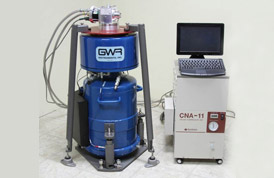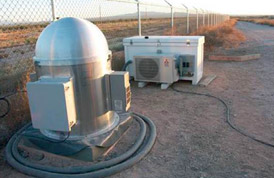iGRAV® Gravity Sensors
Superconducting persistent currents (i) produce the most stable relative gravity meter in existence.
- Super stable: Drift less than 0.5 µGal/month Scale factor constant to better than 1 part in 104 for years!
- Super precise: 1 nanoGal (10-3 µGal) in frequency domain 0.05 µGal in the time domain for 1 minute averaging
- Super low noise: 0.3 µGal/(Hz)½
The iGrav® Superconducting Gravity Meter is portable, easy to use, and much more affordable than the GWR Observatory Superconducting Gravimeters (OSG) used in observatories worldwide in the Global Geodynamics Project1,2. The iGrav® is designed specifically for geophysical applications that require much higher stability and precision than provided by mechanical spring-type gravity meters, but can be set up easily and quickly without the need for an expensive platform, housing or infrastructure.
The iGrav® sg meter has an ultra-low drift of less than 0.5 µGal/month and a virtually constant scale factor. In its cryogenic environment, the iGrav® sg sensor is totally insensitive to local changes in temperature, relative humidity, or pressure. With these properties, the iGrav® sg meter provides a precise and continuous record of gravity variations that occur over periods of days, months, years, or even decades with a stability and precision that sets the highest industry standard.
In contrast, spring-type gravity meters are limited by large, variable, and non-linear drifts greater than several µGal/day and are sensitive to both temperature and pressure. These characteristics obscure and interfere with the analysis of non-periodic gravity signals, which are vital for interpreting and analyzing geophysical processes.
Prices And Options : Contact GWR INSTRUMENTS, INC. for prices and options
Specifications subject to change without notice - 12/01/2009
download
![]() iGrav® Brochure (PDF - 600KB)
iGrav® Brochure (PDF - 600KB)
![]() iGrav® Initial Results Paper (PDF - 636KB)
iGrav® Initial Results Paper (PDF - 636KB)
![]() SG Principles of Operation (PDF - 1.16MB)
SG Principles of Operation (PDF - 1.16MB)
![]() iGrav® SG Meter - Chinese Brochure (PDF - 662KB)
iGrav® SG Meter - Chinese Brochure (PDF - 662KB)
![]() Principles of Operation - Chinese (PDF - 1.15MB)
Principles of Operation - Chinese (PDF - 1.15MB)
Specifications | Dewar | Refrigeration | Principles of Operation | Ease of Operation And Portability | Applications for the iGrav® SG Meter | Features
Specifications
- Gravity Sensor
- Single-sphere Niobium-based transducer
Dewar
- Height (Inc. Cold Head)
- 102 cm
40 in
- Diameter
- 36 cm
14 in
- Weight (Dewar with Sensor Installed)
- 30 kg
65 lb
- Volume
- 16 L of liquid helium (LHe)
- Base Plate and Thermal Levelers (Diameter)
- 55 cm
21.5 in
- Base Plate and Thermal Levelers
- 7 kg
16 lb
Refrigeration
- Coldhead
- Sumitomo SRDK-101D (0.1 W at 4 K)
- Compressor
- Sumitomo CAN-11C, Indoor and air cooled
- Power
- 1.2/1.3 kW single phase 50/60 Hz, 100/120/220V
- Operating Temperature Range
- 4 to 38 °C
Principles of Operation
The iGrav® behaves like a spring-type gravity meter, but is notably different in that it lacks a physical, metal spring. Instead, the function of the mechanical spring of regular spring-type gravity meters is replaced in the iGrav® by the magnetic levitation of a superconducting Niobium sphere in the field of two superconducting persistent coils, operating in series. By utilizing the perfect stability of super currents, a completely stable, non-mechanical spring is created.
The iGrav® sensor design is very similar to the OSG and previous SGs and uses the same principles which have been described in detail previously3. However, two changes have been made to simplify operation of the iGrav®. The first is that the magnetic force gradient (the "spring constant") is permanently set at the factory by adjusting the turns ratio of the upper and lower magnet coils and wiring them in series. Therefore, only the magnitude of one current needs adjustment until the total levitation force precisely balances local g at the site of operation. The second is the use of a small coil that is used only for final centering of the sphere at the center of the capacitive displacement sensor. These two changes eliminate the difficult task of adjusting the gradient and centering the sphere, integral to the operation of earlier SGs.
As a result of the weak gradient, small changes in gravity produce large displacements of the test mass that are easily detected in the capacitive displacement transducer that surrounds the mass. Persistent superconducting currents, the weak gradient, and operation at cryogenic temperatures eliminate the sources of noise and drift commonly found in mechanical-spring gravity meters. As a result, the SG is the world’s most sensitive and stable gravimeter.
Ease of Operation And Portability
The iGrav® consists of three systems: the dewar and base plate, the cryogenic refrigerator, and the control box and portable computer. One main advance of the iGrav® is the reduced size and power consumption of the electronics. This reduction allows the electronics to populate the head of the dewar, which lies directly above the sensor. The iGrav® dewar is smaller and lighter, making it easier for one person to move around. Smaller and lighter thermal levelers are integrated into the base plate (separate from the dewar), which can either be operated resting on a flat concrete surface or bolted in place for long-term measurements.
To maintain the superconducting state, the iGrav® sensor is operated at 4.2 K inside a 16-L dewar filled with liquid helium and integrated with a 4 K refrigeration system. In this "closed cycle" system, the 4 K refrigerator re-liquefies gaseous helium in the neck of the dewar so that it drips back into the dewar's storage volume. Therefore, the iGrav® operates indefinitely without the need for refilling with liquid helium. The refrigerator is low power and consumes only 1.3 kW; however, it has enough refrigeration power to cool the dewar and the sensor from room temperature to 4.2 K and to liquefy helium gas when it is added to the dewar from a pressurized gas cylinder. This method is used to replace any helium lost during maintenance or power failures. Transporting and transferring liquid helium are never needed to initialize or to operate the iGrav® sg meter.
Watch this short video on installing the iGrav®!
Applications for the iGrav® SG Meter
The economy, long-term stability, continuous record, and sub-µGal resolution of the iGrav® sg meter make it an ideal choice for a wide range of applications that include environmental, engineering, and hazard-reduction geophysics. Precise gravity measurements are the only means to determine mass and density changes. Continuous monitoring of gravity with the iGrav® in combination with an instrument such as GPS for monitoring vertical displacement provides a powerful method for understanding long-term crustal movement and subsidence from oil, gas, and water extraction. The correlation of continuous gravity with environmental, hydrological, and other continuous geophysical instruments is essential for the understanding of complex underground geophysical processes. The iGrav® is suitable for a wide range of applications that include:
- An ultra-high-precision continuous gravity reference station for studying a wide variety of geophysical phenomena, with a range in periods from one second to several years
- Monitoring volcanoes-for both their slow deformation and their explosive activity
- Measurement of ocean-loading corrections to gravity for improving global ocean tide models
- Hydrological, geothermal, and non-invasive ground water monitoring
- Measurement of subsidence caused by oil, gas, or water extraction
- Long term tectonic effects-either post-glacial uplift or subsidence
- Subduction-induced silent earthquakes
- Aquifer monitoring and management; measuring depletion and recharging of municipal water supplies
- Gravity measurements around active faults, volcanic systems, and regions of active subsidence for the understanding of their scientific processes and societal hazards
Features
- Sub-µGal precision - 1 nanoGal (10-3 µGal) in the frequency domain 0.05 µGal in the time domain for 1 minute averaging
- Very low drift - drift rate less than 1/2 µGal/month.
- Constant calibration - scale factor remains stable to 1 part in 104 for years!
- More affordable - cost is approximately one-half of Observatory SGs.
- Simplified Initialization and Operation - minimally trained personnel can setup and operate the SG.
- Magnetic gradient ("spring constant") is factory-set and never needs further adjustment.
- Simplified sphere levitation is only done once after initial cooldown and initialization.
- Easily Portable - The iGrav® sg meter is easy to move and set up with modular components that allow for easy transportation by van or pick-up truck.
- Only two electrical cables (DC power and control power cable) need be disconnected from dewar head.
- Coldhead is easily inserted or removed without complex isolation frame.
- Sphere is left levitated and unclamped when instrument is moved.
- Only small centering adjustments are made with a separate circuit at the new site of operation.
- Moving the iGrav® does not affect its calibration factor or its drift rate.
- Integrated data acquisition and control electronics - microprocessor-controlled electronics with A/D converter in dewar head. Real-time controller for high-resolution data logging with 7.5 digit DVM for Gravity Signal and Barometer with GPS time stamp.
- Remote control - system monitoring, control, and data acquisition can be done remotely via an Internet or other TCP/IP connection.
- Operator uses Remote Interface for all functions of initialization, data collection, and monitoring cryocooler and UPS.
- Easy remote control and monitoring of multiple instruments from a home or office.
- Consumes no liquid helium - no liquid helium is ever needed at site of operation.
- During first initialization, the refrigeration system cools down both the sensor and dewar from room temperature and liquefies helium gas provided from gas cylinders.
- Liquid helium lost during power failures or maintenance is replaced by liquefying from gas cylinders.
- Simple power supply system - The electronics in the dewar head operate on 12 volt DC, so that a simple UPS combination of trickle charger and batteries can provide the ultimate protection from lightening.
- Low Maintenance - 10,000-hour recommended coldhead maintenance interval.
- Low power - Complete system consumes less than 1.4 KW at 100-220 VAC, 50/60 Hz.



 Print This Page
Print This Page


